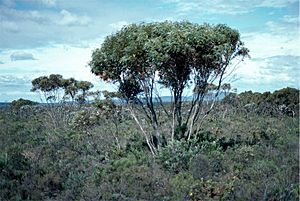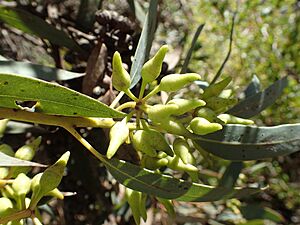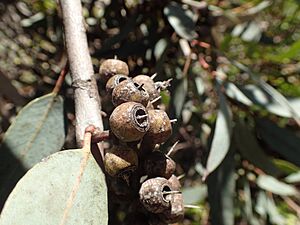Silver mallet facts for kids
Quick facts for kids Silver mallet |
|
|---|---|
 |
|
| Eucalyptus falcata growing in Fitzgerald River National Park | |
| Scientific classification | |
| Genus: |
Eucalyptus
|
| Species: |
falcata
|
| Synonyms | |
|
|
The silver mallet, also known as toolyumuck, is a special type of Eucalyptus tree. Its scientific name is Eucalyptus falcata. This tree is found only in Western Australia. It has smooth bark, long, curved leaves, and pretty creamy white or yellowish-green flowers. Its fruit looks like a flat, round capsule.
Contents
What the Silver Mallet Looks Like
The silver mallet is a type of mallee or marlock. These are usually small trees or large shrubs. It often grows to be about 5 to 6 meters (16 to 20 feet) tall. It has smooth bark that is silvery-gray and green-gray, with hints of pale brown-orange.
Leaves, Flowers, and Fruit
When the plant is young, its leaves are egg-shaped and grow in pairs. They are about 3.5 to 6 centimeters (1.4 to 2.4 inches) long and 2 to 3 centimeters (0.8 to 1.2 inches) wide.
As the silver mallet grows, its adult leaves change. They are arranged one after another along the stem. Both sides of the leaves are the same shade of green. They are shaped like a spear or are slightly curved. These leaves are about 5.5 to 13 centimeters (2.2 to 5.1 inches) long and 1 to 2 centimeters (0.4 to 0.8 inches) wide. Each leaf has a stalk about 1 to 2.7 centimeters (0.4 to 1.1 inches) long.
The flower buds grow in groups of eleven or thirteen. They hang downwards on a stalk that is 7 to 22 millimeters (0.3 to 0.9 inches) long. Each individual bud has a small stem, 1 to 7 millimeters (0.04 to 0.3 inches) long. The mature buds are oval-shaped, about 1 to 1.9 centimeters (0.4 to 0.7 inches) long and 0.5 to 0.8 centimeters (0.2 to 0.3 inches) wide. They have a long, cone-shaped cap.
Silver mallet trees bloom between August and May. Their flowers are creamy white or yellowish-green. After flowering, the tree produces woody, flattened, round fruits. These fruits are about 0.4 to 0.9 centimeters (0.2 to 0.4 inches) long and 0.8 to 1.1 centimeters (0.3 to 0.4 inches) wide. Each fruit also has a small stem up to 0.8 centimeters (0.3 inches) long.
How the Silver Mallet Got Its Name
The silver mallet was first officially described in 1847 by a scientist named Nikolai Turczaninow. He wrote about it in a science journal called Bulletin de la Société Impériale des Naturalistes de Moscou. The plant he studied was collected by another botanist, James Drummond.
The scientific name falcata comes from a Latin word that means "sickle-shaped." This refers to the curved shape of the adult leaves.
The Noongar people, who are the traditional owners of the land where this tree grows, call it toolyumuck.
Where the Silver Mallet Grows
The silver mallet is found in different areas across Western Australia. You can find scattered groups of these trees from near Kojonup to Corrigin and north to Tammin. It grows in several different natural regions, including the Avon Wheatbelt, Esperance Plains, and Jarrah Forest.
This tree often grows on the tops or sides of rocky, lateritic hills. It can be found growing alongside other types of eucalyptus trees, such as the brown mallet (E. astringens) and the salmon gum (E. salmonophloia).
Conservation Status
The Western Australian Government's Department of Parks and Wildlife has classified the silver mallet as "not threatened." This means it is not currently at risk of disappearing.



